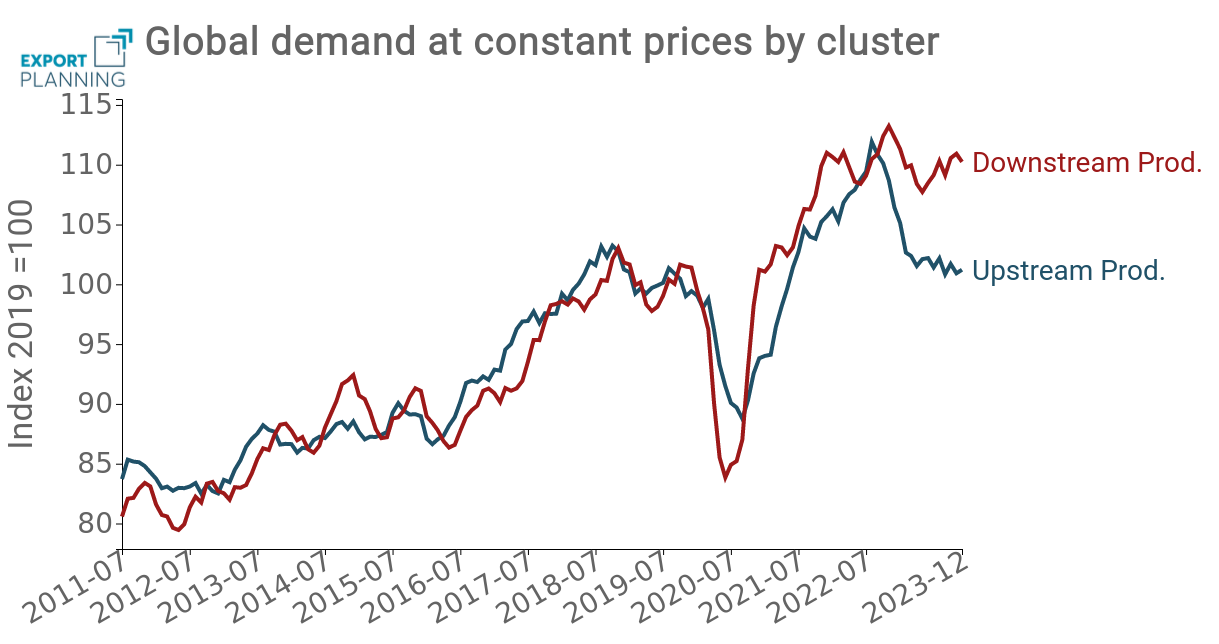Positive Signals from Global Trade
Even in 2024, Global Trade Could Provide a Significant Contribution to World Economic Growth
Published by Luigi Bidoia. .
Global demand Global economic trends
Log in to use the pretty print function and embed function.
Aren't you signed up yet?
signup!
Analyzing large datasets to extract meaningful information is often a complex and non-immediate process. Generally, it requires intricate transformations of raw data to isolate signals of interest.
A particularly relevant example can be found in the analysis of data available at the end of 2023 on the dynamics of global trade, a crucial element for understanding global economic trends. The European economic crisis, particularly centered on the German industrial downturn, and the slow recovery of the Chinese economy are raising concerns about a potential prolongation of the global economic weakness phase, which could extend throughout next year.
Benefits of World Trade Statistics
Information derived from global trade offers significant advantages in analyzing the global economic cycle. Among these, the timeliness of customs data, which is published with only a two to three-month delay, allows for a near real-time analysis of economic trends. Furthermore, the extensive geographical coverage of these statistics provides an indispensable global view in an interconnected economy. Finally, the accuracy of the measurements, ensured by the dual declaration of trade flows, guarantees the reliability and precision of the data.
Recent signals
Recent positive data from global trade are particularly important as they provide a less negative perspective on the global economic situation. However, the analysis of the signal discussed in this article[1] is not straightforward and requires two complex processing stages:
- Decomposition of the Dynamics of Flows: It is necessary to separate the dynamics of trade flows in value into two distinct components: prices and quantities. It is the dynamics of quantities that provide an indirect measure of the global economic cycle. Prices, on the other hand, are influenced by a variety of other factors.
- Decomposition of Flows into Significant Clusters: This stage involves categorizing trade flows into relevant clusters of countries or products. This decomposition is particularly complex as it is not predefined, but depends on the varying characteristics of the global economic cycle. In the most recent phase of the cycle, a particularly significant distinction is between upstream and downstream products in various production chains.
The following graph shows the dynamics of world trade at constant prices (i.e. net of price effect), broken down for the two clusters of upstream and downstream products.

Analysis of the graph reveals the following facts:
- cyclical trends in the global trade of upstream products generally tend to precede those of downstream products. This phenomenon aligns with standard production cycles and the key role of production input purchases in forecasting future demand;
- However, during the economic cycle caused by the pandemic, the trade of upstream products did not follow its usual pattern of preceding downstream trade. This was due to the complete disruption of global production and logistical cycles caused by the pandemic;
- Even in 2023, the trade of upstream products did not indicate an upcoming growth phase. Expectations of price reductions and high interest rates have kept the costs of upstream inventories high, leading companies to reduce inventory levels;
- In recent months, the global trade of downstream products has shown clear signs of recovery, especially after the significant downturn between the end of 2022 and the beginning of 2023. This id the most significant aspect among those mentioned. It suggests that, despite the current high uncertainty, there are factors capable of supporting the growth of global trade.
Conclusions
There is no doubt that, over the past 30 years, the growth of global trade has been one of the main drivers of the world economy's development. However, recently, the emergence in developed nations of issues related to the offshoring processes in low-cost countries and the intensification of geopolitical tensions in various parts of the world have lessened the impact of trade on global economic growth.
Despite this, recent positive signs in the global demand for downstream products suggest that, in 2024, trade might once again contribute to the growth of various world economies.
Nevertheless, it is crucial to maintain a cautious approach, especially considering the current crisis in navigational security in the Red Sea and its potential impacts on global naval logistics
[1] For a broader description of the analysis of the world trade conjuncture, see the following article:
Q4 2023: Global Trade Outlook


